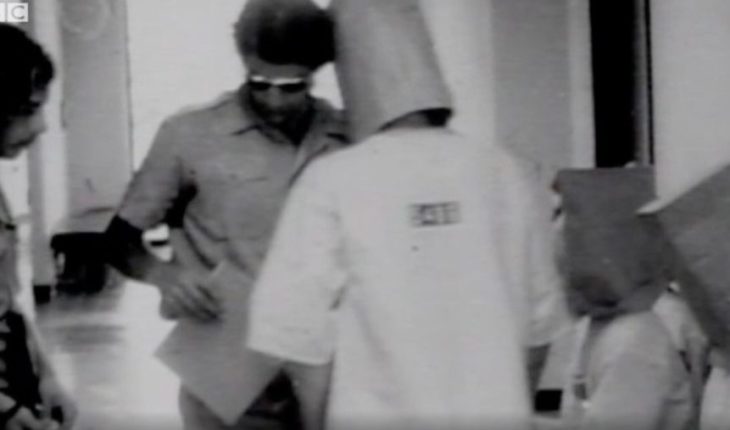Eric was suspended by his wickedness. E CastroPlaca that reminds the Stanford Prison experiment, in 1971, which is still controversial. It is one of the most famous psychological studies of history and it has been so many times that some already consider it a myth.
You might sound: a College Professor of Psychology recruits a group of students and asks them to imagine that they are in a prison. He appoints some guards and other prisoners.
In a few days, the “jailers” become so sadistic and abuse so of their “prisoners” that the experiment should be suspended.
It happened really, in 1971, and not on any side: in one of the most prestigious universities in the United States: Stanford, in California.
How it all started? The roots of the experiment have been mapped to another controversial psychological study carried out a decade earlier at another famous American University of Yale.
This study is known as “the Milgram experiment” because it was directed by the psychologist from Yale Stanley Milgram.
Milgram wanted to analyze the obedience to authority.
Getty ImagesLa most of the nazis accused in the Nuremberg trials said that they had “obeyed orders” and so were innocent. His inspiration were the Nuremberg trials that judged Nazi crimes after the second world war. Most of the defendants had based his defense on the fact that simply were “following orders” from his superiors.
Milgram wanted to find out to what extent a human being “good” is able to cause damage to another by following orders.
Their experiment was very controversial because it deceived the participants, telling them that it was a study on memory and learning.
40 volunteers divided into two random groups: some said that they would be teachers and other students who would be.
Then took the “students” to another room and asked “professors” that put to test the memory of his alleged students.
He told them that if they were wrong they should punish them with an electric shock. The machine used for this broadcast downloads ranging from 50 to 450 volts. The maximum had written down a warning saying: “danger: severe shock”.
BBCA despite this, following the orders received, 65% of the “teachers” ended up applying the highest discharge, while the cries of the so-called students in the next room could be heard. It turned out the machine not emitted voltage and the screams were recordings. But the truth is that the controversial Milgram experiment found that the majority of people were willing to physically harm to another rather than confront the person who gave them the order.
Prison of Stanford a decade later, a Professor of social psychology at Stanford University named Philip Zimbardo wanted to take the Milgram experiment a step further and discuss how thin is the line separating the good from the bad.
Zimbardo wondered if a “good” person could change their ways according to context in which it was.
He pulled out a notice offering daily $15 volunteers who were willing to spend two weeks in a false imprisonment.
The experiment was funded by the Government of USA, I wanted to understand the origin of conflicts in its prison system.
Zimbardo selected 24 students, most white and middle class, and divided them into two groups, randomly assigning the role of guardian of the prison or prisoner. Then let them return to their homes.
The experiment began brutally: real cops (who agreed to participate in the project) were presented in the homes of the “prisoners” and arrested them, accusing them of stealing.
They were handcuffed and taken to the police station, where joined them, and then they were transferred – blindfolded – to a so-called provincial prison (in reality the basement of the Department of psychology at Stanford, which had been transformed into a prison in appearance very real).
BBCImagen extracted from recordings of the experiment of Stanford in 1971, issued in a report by the BBC 2011. There, the volunteers were stripped naked, inspected, despiojados, disinfected and received a uniform that consisted of a long shirt with a number (no underwear), rubber sandals and a nylon Cap made with female socks.
Ankles, volunteers who were guards placed a heavy chain.
What happened then would end up causing so much shock that he would eventually inspire not a nor two, but three films (a German in 2001 and two Hollywood in 2010 and 2015) as well as countless books and articles.
Sadists just began the experiment, the guards began to show abusive behavior which soon became sadistic.
Even though they had been instructed to not physically harm the prisoners, they carried out all kinds of psychological violence.
They identified the prisoners with numbers, avoiding calling them by name, constantly sent them to solitary confinement, stripped them, forcing them to do pushups, sleep on the floor, put them bags of paper over their heads and forced them to defecate in buckets.
“The first day that arrived, was a small prison installed in a basement with false cell. “The second day was a real prison created in the mind of each prisoner, each guard and also staff”, Zimbardo told the BBC in 2011, when marked 40 years since his famous experiment.
Several of the prisoners began to show emotional disorders.
“The most effective thing they (the guards) was simply to disrupt (our) dream, which is a well known technique of torture”, told the BBC in 2011 Clay Ramsey, one of the prisoners.
However only a few of the students dropped out.
Dave Eshleman, one of the young guard, he recalls that he took the experiment as a kind of acting game.
“After the first day, I noticed that not passing anything. It was a little boring, so I took the decision to play the part of a very cruel prison guard,”he revealed.
The so-called “Stanford Prison experiment” reached levels so perverse that it had suspended less than a week after starting. In total lasted six days.
BBCIba to last two weeks but was suspended six days. Zimbardo conclusion was clear: the situation influences human behavior and put good people in a bad place makes them act badly or resign themselves to being abused.
However, with the passage of the years began to arise many questions to this theory that we are all potential sadistic or masochistic.
The main question had to do with the role that he played the own Zimbardo, who acted as the “Superintendent” of the prison during the experiment and would have advised and encouraged the performance of the “guards”.
But despite the controversy, Zimbardo, who gained great notoriety and today is considered an eminence in his field, continues to maintain that its study was a valuable addition to the psychology and serving to understand phenomena such as abuses in prison Iraqi Abu Ghraib.
Getty ImagesZimbardo at the premiere of “The Stanford Prison Experiment” (2015), the latest film about the controversial experiment.” (El estudio) tells us that human nature is not totally under the control of what we like to think of as free will, but that most of us can be seduced to behave in a completely atypical manner with respect to what we believe that we are ” , you said to the BBC.
Now you can receive notifications of BBC world. Download the new version of our app and activate them so you don’t miss our best content.
translated from Spanish: How was the experiment of the prison from Stanford
December 3, 2018 |





